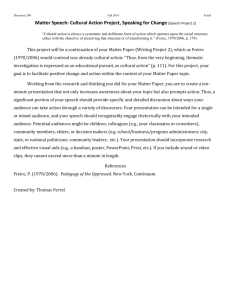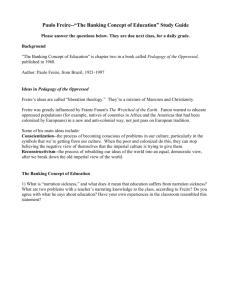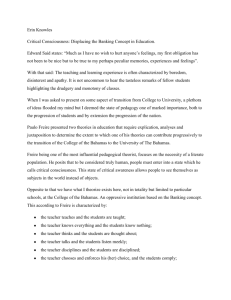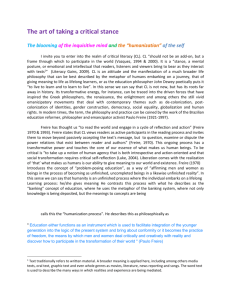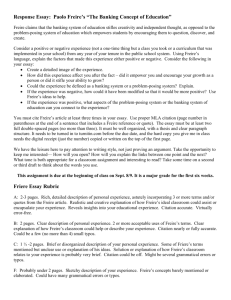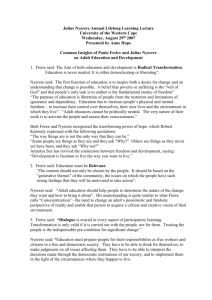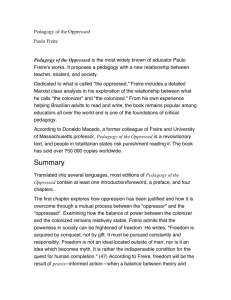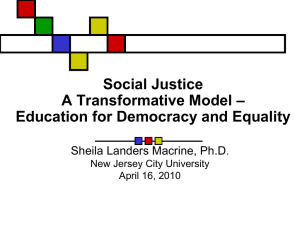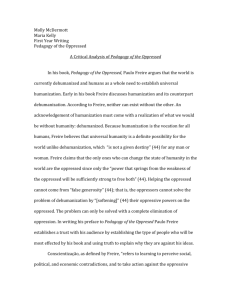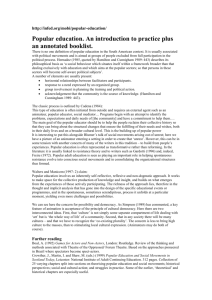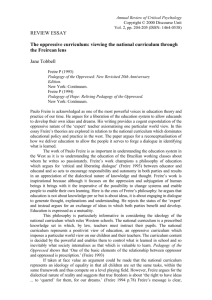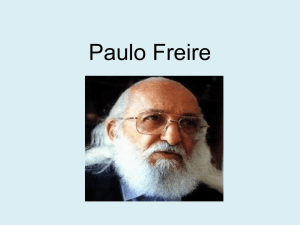Pedagogy of the oppressed - critical
advertisement
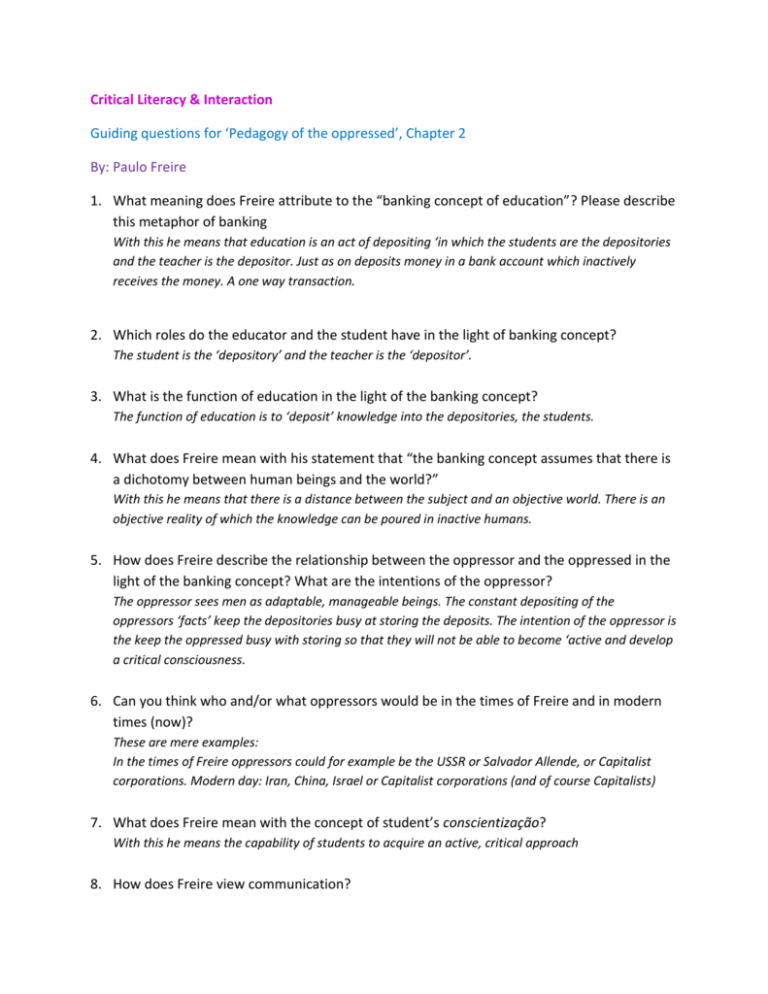
Critical Literacy & Interaction Guiding questions for ‘Pedagogy of the oppressed’, Chapter 2 By: Paulo Freire 1. What meaning does Freire attribute to the “banking concept of education”? Please describe this metaphor of banking With this he means that education is an act of depositing ‘in which the students are the depositories and the teacher is the depositor. Just as on deposits money in a bank account which inactively receives the money. A one way transaction. 2. Which roles do the educator and the student have in the light of banking concept? The student is the ‘depository’ and the teacher is the ‘depositor’. 3. What is the function of education in the light of the banking concept? The function of education is to ‘deposit’ knowledge into the depositories, the students. 4. What does Freire mean with his statement that “the banking concept assumes that there is a dichotomy between human beings and the world?” With this he means that there is a distance between the subject and an objective world. There is an objective reality of which the knowledge can be poured in inactive humans. 5. How does Freire describe the relationship between the oppressor and the oppressed in the light of the banking concept? What are the intentions of the oppressor? The oppressor sees men as adaptable, manageable beings. The constant depositing of the oppressors ‘facts’ keep the depositories busy at storing the deposits. The intention of the oppressor is the keep the oppressed busy with storing so that they will not be able to become ‘active and develop a critical consciousness. 6. Can you think who and/or what oppressors would be in the times of Freire and in modern times (now)? These are mere examples: In the times of Freire oppressors could for example be the USSR or Salvador Allende, or Capitalist corporations. Modern day: Iran, China, Israel or Capitalist corporations (and of course Capitalists) 7. What does Freire mean with the concept of student’s conscientização? With this he means the capability of students to acquire an active, critical approach 8. How does Freire view communication? Communication is the situation in which teacher and student are both accepted in their humanity, they are both active and authentic. This creates a dynamic process instead of a static process. 9. What is the difference between biophily and necrophily? What point does Freire wants to make with this distinction in relation to his view on human nature? Biophily is the situation in which a student is active instead of just a receptor. Necrophily is a dead static situation in which the student is inactive, a receptor. His point is that in order to be really human, alive, we need a biophile attitude, because a banking approach is dead and mechanical. 10. What results does necrophily has on humans according to Freire? Necrophily makes humans static receptors, dead mechanical beings, this dehumanizes them. 11. What is the paradox of liberation in the light of what Freire calls the dehumanization process? Dehumanizing the oppressed dehumanizes the oppressor. Thus by freeing themselves the oppressed free the oppressor. 12. What does Freire mean with the concept of the process of humanization? By making the oppressed static the oppressor takes away their humanity, he makes them dead beings. This is a process of dehumanization. 13. What is liberating education in Freire’s view and how does this relate to the process of humanization? With liberating education the oppressed can be freed from their dependence on the oppressor, by becoming authentic. This humanizes the oppressed. 14. Which role does problem-posing and dialogue play in this process of humanization? With problem posing and dialogue the oppressed are made into Subjects just as the teacher. This constructs dialogue instead of a monologue of the teacher. The authenticity this gives the student humanizes him. 15. How does Freire describe the student, the teacher and the student-teacher relationship in the light of what he calls liberating education? Both the student as well as the teacher become subjects in this process. 16. “ La conscience et le monde sont donnes d’un même coup” What does Freire mean with Sartre’s citation? The world does not create consciousness, they are created simultaneously. 17. In which ways does problem posing education differ from the banking concept of education? Problem posing education challenges students to take an active, critical approach in contrast to banking education which presupposes an inactive receptive student. The former demythologizes, while the latter mythologizes. 18. Freire describes a movement that will emerge when individuals start being conscious of their role in their own liberating process. What are the main characteristics of this movement Freire describes as the “movement of inquiry”? This movement is directed towards humanization: “The people’s historical vocation, the pursuit of full humanity. This cannot be carried out in isolation or individualism, but only in fellowship and solidarity. Problem-posing education, as a humanist and liberating praxis (practice) as fundamental that the people subjected to domination must fight for their emancipation. To that end, it enables teachers and students to become Subjects of the educational process by overcoming authoritarianism and alienating intellectualism: it also enables people to overcome their perception of false perception of reality. The world –no longer something with the deceptive words- becomes the object of that transforming action by men and woman which results in their humanization.” (Freire, 1970 (reprinted 2010), p.86) 19.Please reflect on your own education journey until now in terms of Freire? 20.What do you think of Freire’s view on education and human beings? 21.How do you see your role in the world? 22.What challenges do you encounter when you reflect on these issues?
